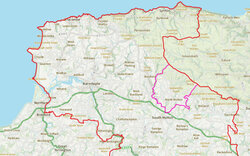About North Molton Village
North Molton sits on the south-western edge of Exmoor National Park, about 3 miles from the market town of South Molton and the A361 link road. Set in glorious countryside, the village and outlying hamlets and farms are currently home to around thirteen hundred residents. It is a happy, thriving community with a primary school, two churches, two pubs, a garage, a hairdressers and a variety of home-based businesses. There are two well-supported village halls and a sports club boasting football and cricket pitches and an indoor sports hall and pavilion.
The spirit of the community is captured in the book North Molton a celebration of the people and history of North Molton published by the North Molton History Society. The village was originally founded on the very successful wool trade, followed by a brief spell as a mining village. As the local saying goes "When North Molton was a thriving town South Molton was still a fuzzy down".
 Interactive Map of North Devon
Interactive Map of North Devon
Historical Timeline
-
2021
Population 1,159.
-
2011
Population 1,094.
-
2001
Population 1,047.
-
1924
The Victory Hall built to commemorate the fallen of the village in World War I. -
1901
Population 1,080.
-
1891
Current Methodist chapel constructed. -
1841
Population 2,121.
-
1837
First Methodist chapel constructed. -
1800s
Mines at North Radworthy producing copper and some gold; Bamfylde Mine opened on the River Mole, producing iron, copper and manganese (closed 1877), and Florence Mine was worked for iron, copper and lead until 19885, having a rail link to South Molton from 1874. -
1801
Population 1,541
-
1710
The Old Corn Mill was constructed by the River Mole. -
1610
Population 660.
-
1600
Court Hall built to the immediate east of the church by Amyas Bamfylde (now partially demolished). -
1550
Edmund Parker granted the office of bailiff of the manor, and built Court House to the west of the Church in 1553. -
1540
Population 603.
-
1500s
Mines established near Heasley Mill. -
1470s
All Saints Church built by the village square. -
1270
Roger da Zoche granted a licence to hold a weekly market in the manor. -
1086
Doomsday Survey showed a community of 120 households and about 570 people. -
Bronze Age
Tracks, barrows and stone circles constructed on the moors. -
Neolithic
Evidence of flints used by early inhabitants.